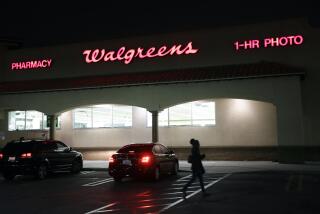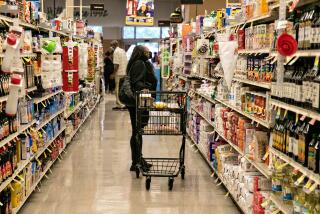Amazon slashes Whole Foods prices by up to 43 percent on first day

After falling 37 percent this year on disappointing sales and investor concern over the Amazon-Whole Foods union, Kroger fell 0.5 percent on Monday. (Aug. 28, 2017) (Sign up for our free video newsletter here http://bit.ly/2n6VKPR)
- Share via
Lee Adams carefully reviewed her receipt after shopping at a Whole Foods Market in Venice on Monday and was a little disappointed to find that prices were unchanged for her list of vegan groceries.
“The prices are the same so far for the things I buy,” Adams said.
But that’s likely to change — and soon.
Amazon.com Inc. immediately slashed prices by up to 43% for some of Whole Foods’ bestselling products Monday, the day its $13.7-billion purchase of Whole Foods Market Inc. was completed.
Prices were lowered for Whole Foods’ bananas, large brown eggs, salmon, avocados, baby kale and almond butter, among other groceries.
Amazon had said last week that it would cut prices when the deal closed so that Whole Foods — whose natural and organic products often carried premium prices that resulted in the upscale chain being derisively dubbed “Whole Paycheck” — would instead start to become “affordable for everyone.”
“It’s impressive they would execute the pricing strategy so quickly,” said Mark Hamrick, senior economic analyst at Bankrate.com.
More price cuts on more items are expected at the 470 Whole Foods stores in the United States, Canada and Britain, and Whole Foods said the price cuts were not temporary.
It’s that aggressive approach to pricing, a hallmark of Amazon, that has sent shock waves through the $611-billion U.S. grocery industry.
Rival supermarket chains, which already operate with thin profit margins, are expected to face further pressure to keep prices down and strengthen their loyalty programs or risk losing shoppers to Whole Foods.
Stocks of rival grocers fell again Monday in response to Amazon’s move.
Shares of Kroger Co., which owns the Ralphs chain in Southern California, slipped two cents to $21.72 and now have plunged 37% so far this year. Sprouts Farmers Markets Inc. tumbled 9.7% to $19.72. Supervalu Inc. dropped 2.2% to $19.76. Meanwhile, Amazon edged up 76 cents to $946.02.
Amazon, the e-commerce giant, also plans to give its Amazon Prime members further price savings and other in-store benefits at Whole Foods. Amazon already is selling its Echo and Echo Dot voice-assisted devices in Whole Foods stores as part of its plan to integrate the two companies.
Prices of organic bananas were cut 30% to 69 cents a pound from 99 cents; organic avocados fell 29% to $1.99 from $2.79, and organic rotisserie chicken dropped 29% to $9.99 from $13.99.
Store displays showed the “new lower price” on items along with the prior price, along with signs that said “We’re Growing Something Good — Whole Foods + Amazon.”
“If it’s not a gimmick and [prices] go lower and stay low, that would be amazing,” Adams said. “Whole Foods is so expensive.”
Danny Hillel, another shopper at the Whole Foods store in Venice, said he noticed that prices for sandwiches and pizza were unchanged. But he welcomed the trend toward lower prices.
“If the prices do go lower probably I would shop more here,” Hillel said. “It’s a great thing as long as the quality stays the same.”
Whole Foods was struggling before Amazon announced its buyout plan in mid-June. A combination of Whole Foods’ lofty prices and inroads by rival supermarkets in selling their own organic and natural foods had slowed Whole Foods’ growth.
“A great brand was on the verge of irrelevance (or at a minimum, marginalization)” before Amazon swooped in, analyst Karen Short of Barclays Bank said Friday in a note to clients.
Now, “price reductions will likely be broad-based” at Whole Foods, and that means “goodbye Whole Foods as we know it,” Short wrote.
When asked to comment on Amazon and Whole Foods’ moves, Kroger spokeswoman Kristal Howard said that her own company is “very proud of the role we’ve played in making natural and organic products more affordable and accessible to all customers, especially for shoppers on a budget,” and that Kroger has an “unending commitment to lower prices on conventional products as well.”
Albertsons Cos., a privately held firm that owns the Albertsons, Vons and Pavilions grocery chains, declined to comment.
Besides lowering prices for all Whole Foods shoppers, Amazon could kick-start Whole Foods’ growth by tying the grocery chain to its Prime membership, which costs $99 a year and includes free shipping of Amazon products as well as video streaming.
Whole Foods’ prices “were off-putting to a lot of potential customers and for good reason; a substantial part of the population felt it couldn’t afford to shop at Whole Foods,” Hamrick said.
But many of those people probably have Prime membership and “now will get an added incentive to shop at Whole Foods” because Prime will, in effect, become a Whole Foods reward program, he said.
Amazon does not disclose the number of Prime accounts, but analysts estimate the figure is 65 million or more.
Amazon also plans to add Amazon Lockers at select Whole Foods locations, enabling any customer who buys a product on the Amazon.com website to pick up or return the item at the Whole Foods store.
More to Read
Sign up for Essential California
The most important California stories and recommendations in your inbox every morning.
You may occasionally receive promotional content from the Los Angeles Times.












